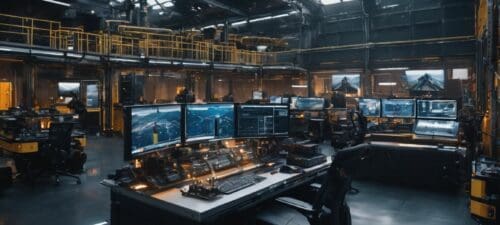Fortnite Ballistic vs CS2 Comparison: Features, Gameplay, and More
Updated On: October 25, 2025 by Aaron Connolly
Core Differences Between Fortnite Ballistic and CS2
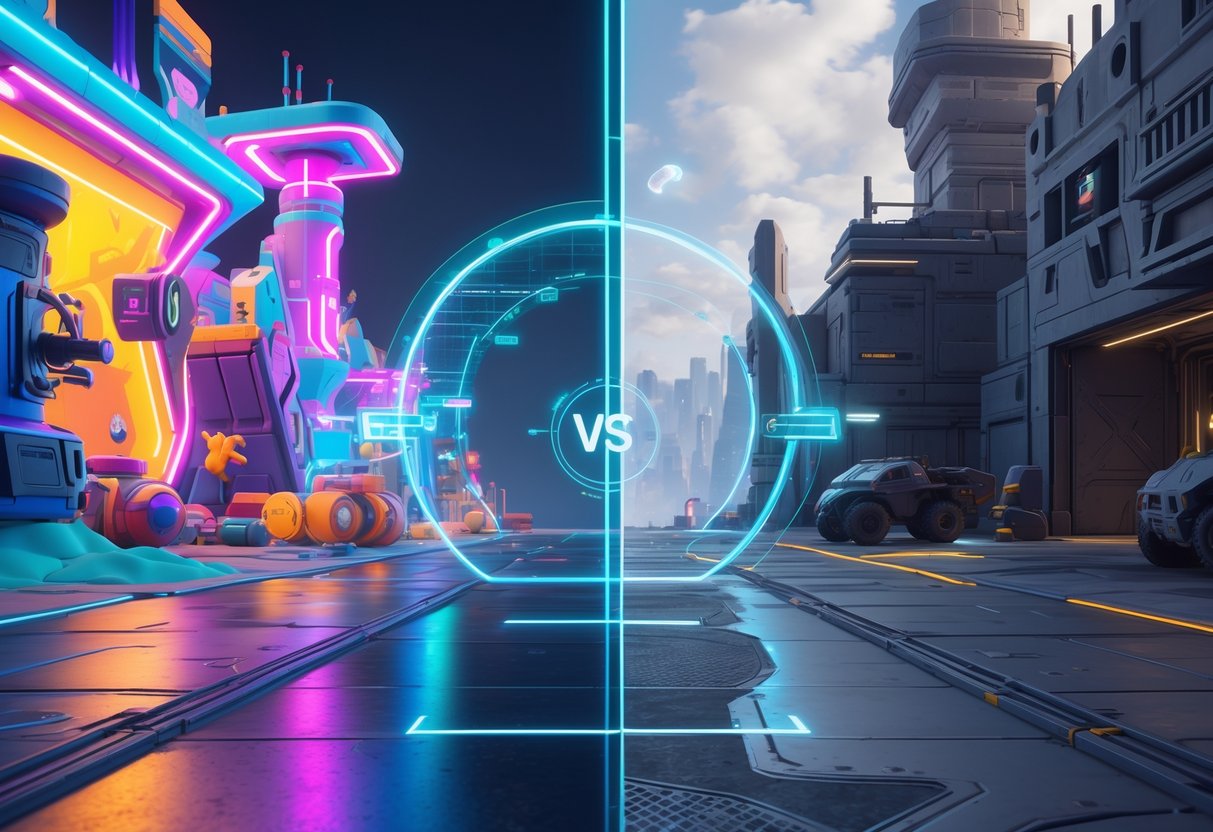
Both games stick to the 5v5 tactical shooter format, but Fortnite Ballistic and CS2 couldn’t feel more different in pacing and overall vibe. Each game really goes after its own audience, thanks to their unique mechanics and design choices.
Gameplay Pace and Style
Match Duration is one of the first things you’ll notice. CS2 matches can stretch out for 30-60 minutes since teams need to snag 13 rounds to win.
Fortnite Ballistic, on the other hand, wraps things up way faster. You only need 7 rounds to win, so most matches end in about 15 minutes.
Each round in Fortnite Ballistic runs for 1:45, with a 25-second freeze time. This means players make decisions quicker, but it doesn’t offer as much strategic depth as CS2’s longer rounds.
Weapon Economy really sets them apart too. CS2 brings more than 20 weapons, from sniper rifles to SMGs, and lets players share or drop weapons for teammates.
Fortnite Ballistic keeps things tighter, with about 10 weapons. The Flex gadget system stops players from sharing—once you grab a gadget, it’s yours alone for that match.
Map Variety is another big one. CS2 boasts 15-16 maps across its modes, showing off its long history. Fortnite Ballistic? Right now, there’s just one map: Skyline 10, with two bomb sites.
Perspective and Aiming Mechanics
During matches, Fortnite Ballistic sticks to a first-person perspective. That’s a big shift from Fortnite’s usual third-person battle royale view.
CS2 has always been about first-person tactical shooting, and after years of updates, the aiming feels super polished.
Movement systems set the games apart as well. Fortnite Ballistic borrows some of Fortnite’s signature movement smoothness, so things feel more fluid. CS2 keeps its classic counter-strafing and sharp, deliberate movement.
The shooting physics in Fortnite Ballistic feel closer to Valorant than CS2. Rounds are a bit more forgiving, which can be a relief for casual players.
Recoil patterns in CS2 take ages to truly master. Fortnite Ballistic feels more approachable for newcomers, but still leaves room for skilled play.
Target Audience and Core Appeal
Game Status says a lot about each game’s direction. CS2 stands alone as a full game, with over two decades of franchise history behind it. Big gameplay changes happen rarely.
Fortnite Ballistic is just a mode inside Fortnite’s bigger world. Epic Games can shake things up at any time before making it a permanent thing.
Player Base highlights their differences. CS2 attracts die-hard tactical shooter fans. Some players have poured thousands of hours into Counter-Strike.
Fortnite Ballistic aims at Fortnite fans who are curious about tactical shooters or just want something a little less intense and time-consuming than CS2.
Competitive Scene really shows the gap. CS2 inherited Counter-Strike’s massive esports tournaments and prize pools. Professional teams, coaches, and analysts have built their careers around it.
Fortnite Ballistic does have ranked play, but there’s no established esports scene yet. Its competitive future depends on whether Epic decides to invest long-term.
Game Modes and Structure
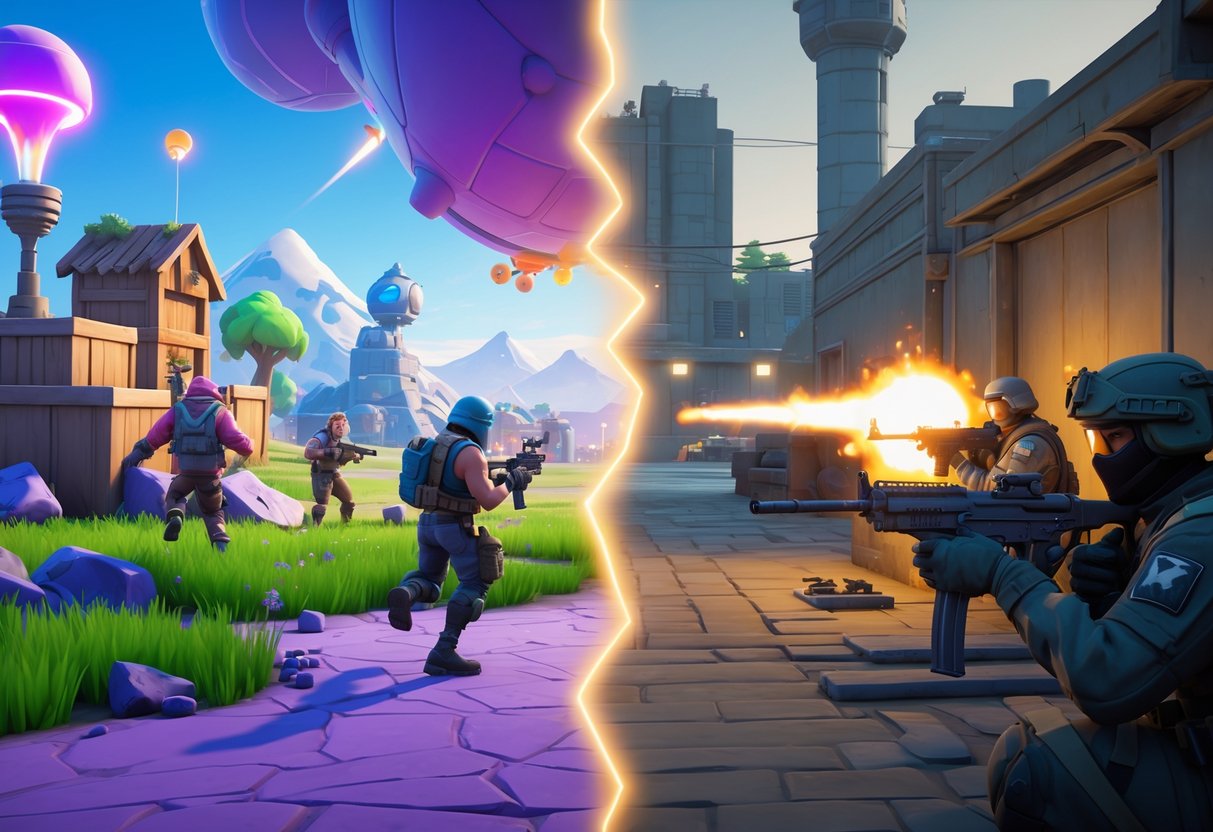
Both games stick to the 5v5 tactical shooter formula, but how they structure matches leads to very different gameplay. Fortnite Ballistic goes for faster, shorter matches, while CS2 holds onto the longer format that competitive players expect.
Bomb Planting Objective
The main objective is the same in both games. Teams switch between attacking and defending each round.
Attackers try to plant a device at one of two bomb sites. Defenders either eliminate all attackers or defuse the bomb before time runs out.
Fortnite Ballistic has the Skyline 10 map with two bomb sites. The planting process looks a lot like CS2’s, but with Fortnite’s visual twist.
CS2 gives players over 15 maps in different modes. Each map has its own layout and strategies, so there’s a lot more to learn.
The bomb timer and defusal work about the same in both games. But CS2’s larger map pool means players need broader tactical knowledge.
Round System Overview
Rounds work differently in each game, which changes the flow and pacing.
Fortnite Ballistic needs just 7 round wins for victory. Matches usually take 15-25 minutes, which is great if you don’t want to commit to a long session.
Teams swap sides after a few rounds. The shorter format keeps things moving and lowers the time investment.
CS2 asks for 13 rounds to win in competitive mode. Matches often last 30-60 minutes, especially if teams are evenly matched.
The longer format lets teams dive deeper into tactics and makes comebacks possible.
Both games reset player economies and positions between rounds. In CS2, the longer matches create more complicated economic decisions.
Ranked Versus Unranked Modes
Ballistic mode is still in early access and doesn’t have a full competitive structure yet. CS2, meanwhile, offers both ranked and unranked options.
Fortnite Ballistic doesn’t have a full ranked system yet. You can find the mode in Fortnite’s menu, but ranked play isn’t a thing right now.
The focus is really on introducing tactical shooting to Fortnite’s audience. If the mode takes off, Epic might add ranked features down the road.
CS2 offers Premier mode for ranked play, plus casual matchmaking. The ranking system goes from Silver up to Global Elite, with lots of skill groups.
Unranked matches use the same rules but don’t affect your rank, so you can try new strategies or play with friends of any skill.
The established ranking system gives competitive players a clear way to track progress and improve.
Weapons and Equipment Variety
Each game has its own take on weapons and tactical gear. Fortnite Ballistic feels a bit more like Call of Duty, with accessible gunplay, while CS2 sticks to its roots with precision shooting and rewards for standing still and counter-strafing.
Shotguns and Pistols
Fortnite Ballistic brings two shotguns for different playstyles. The Frenzy Auto Shotgun costs 1,600 credits and dishes out steady damage with its automatic fire. It’s a lot easier for new players to handle than a pump-action.
The Hammer Pump Shotgun packs a punch up close for just 900 credits. One solid shot can drop an enemy, but the slow reload is risky if you’re not confident.
For pistols, there’s the Hand Cannon at 800 credits, with 7 rounds. It’s meant to be like CS2’s Desert Eagle, but honestly, it feels a bit weak right now. The Ranger Pistol is your starter sidearm, with 12 rounds and simple iron sights.
CS2 approaches weapons differently. There aren’t as many shotgun choices, but aim matters a lot more. The Nova and XM1014 each have their own place in the economy. CS2’s pistols—Glock-18, USP-S, P250, and Desert Eagle—each come with their own spray patterns and quirks.
Rifles and Snipers
Fortnite Ballistic focuses on three main rifles. The Striker AR is the go-to for most, costing 2,500 credits with 30 rounds and easy-to-control recoil.
The Nemesis AR also costs 2,500, but only has 25 rounds and a slower fire rate. Its holo sight is easier to see through than the Striker’s red dot. The Enforcer AR is more like a marksman rifle, with 12 strong shots at 2,000 credits.
The Reaper Sniper Rifle acts as Ballistic’s AWP. It’s 5,000 credits, holds 3 rounds, and scores one-shot kills to the head or body. Not for the faint of heart!
CS2’s rifles—AK-47, M4A4, M4A1-S, and others—demand tons of practice to master. The AWP is the king of snipers, while the Scout is a cheaper backup. Every weapon has its own tricks, like counter-strafing and spray control.
Grenades and Tactical Gadgets
Fortnite Ballistic shakes things up with its Flex Gadget system. You pick one kit for the whole match. The Recon Grenade Kit highlights enemy spots, which is great for checking bomb sites or sneaky corners.
The Bubble Grenade Kit gives you temporary shields—super handy for pushing or retaking. Flashbangs and Smoke Grenades are available to everyone as consumables. Frag Grenades clear out campers, and Proximity Mines can stop bomb defusals.
Heads up: The Impulse Grenade Kit just flings you away—not really as useful as the others.
CS2’s utility is all about teamwork and timing. You can buy HE grenades, flashbangs, smokes, incendiaries, and decoys. Each costs $200-600 and has a specific tactical use. At higher levels, smokes and flashes can decide the round.
The main difference? Ballistic’s gadgets are easier for casual players to use, while CS2’s utility takes more know-how and coordination.
Movement and Mobility Options
Movement mechanics might be the biggest divide between these two games. Fortnite Ballistic offers faster, smoother movement, while CS2 sticks to precise, controlled positioning.
Sliding and Vaulting
Fortnite Ballistic hands players a bunch of movement options that CS2 just doesn’t have. You can sprint, slide, and vault over obstacles in the heat of the match.
Sliding works a lot like it does in Fortnite’s main modes. You can zip around corners or duck behind cover fast, which makes fights feel way more dynamic.
Vaulting lets you climb over boxes, walls, and other barriers. In CS2, those same obstacles would block you completely, unless you get help from a teammate.
These extra moves make Fortnite Ballistic feel a bit like Call of Duty or Apex Legends. The action flows faster when you’re not stuck just walking and jumping.
CS2 keeps things basic on purpose. You get walking, running, crouching, and jumping—nothing fancy. Every move has to be thought out, since repositioning takes time and leaves you exposed.
Sprint Speed Differences
The speed gap between the games is actually pretty wild. Fortnite Ballistic lets you move a lot faster than CS2 in almost every situation.
Base movement speed in Ballistic just feels quicker. Even walking is faster than CS2’s usual pace. Add sprinting and you’re flying compared to CS2.
Sprint mechanics are different too. In Fortnite Ballistic, you can sprint without losing much accuracy. CS2 punishes you with awful aim if you try to shoot while running.
This speed changes the whole feel of a match. Fortnite Ballistic rounds are more action-packed, and players can rotate between bomb sites in a flash. Teams can recover from mistakes or make bold plays more easily.
CS2’s slower pace forces everyone to think before moving. Every step counts, since repositioning is slow and risky.
Map Design and Visual Aesthetics
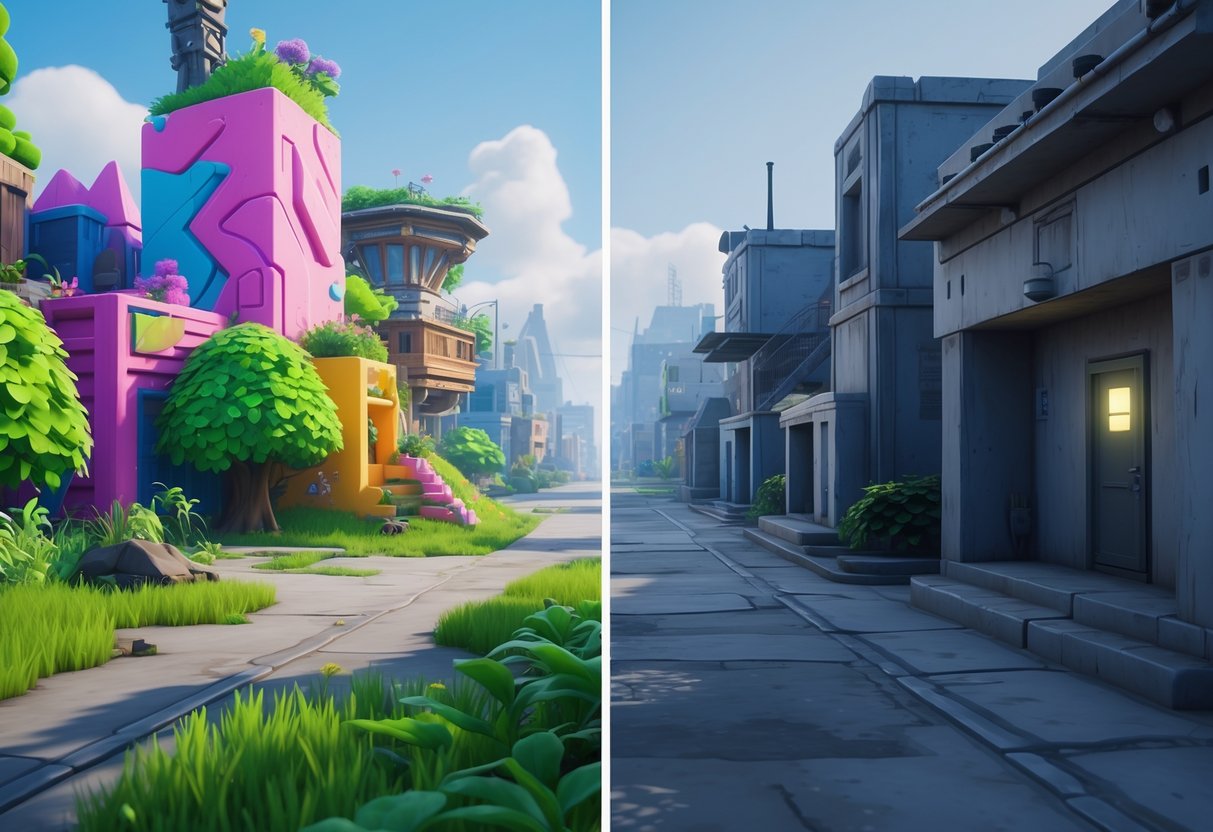
Fortnite Ballistic only offers one map right now—Skyline 10—while CS2 gives players over 15 maps across different game modes. The visual styles couldn’t be more different, either. Ballistic goes for bright, cartoony environments, and CS2 sticks with a gritty, realistic look.
Skyline 10 Versus CS2 Maps
Fortnite Ballistic comes with just one map, Skyline 10. It’s got two bomb sites packed into a tight layout, so matches tend to move fast.
The design borrows a lot from Valorant’s map philosophy instead of CS2’s classic approach.
CS2, on the other hand, throws players into more than 15 maps. You’ll see favorites like Dust2, Mirage, and Inferno pop up all the time.
Every CS2 map brings distinct layouts, tricky angles, and unique strategies to learn.
With Ballistic’s single map, things can get stale fast. Players pick up on Skyline 10’s hiding spots and sight lines way quicker than they would across CS2’s sprawling map pool.
Map variety at a glance:
- Fortnite Ballistic: 1 map (Skyline 10)
- CS2: 15+ maps in both competitive and casual
Visual Style and Environments
Ballistic keeps Fortnite’s cartoony look alive—bright colors, stylized characters, the whole vibe. The maps feel playful, and that makes tactical shooting less scary for folks new to the genre.
CS2 goes in the opposite direction with gritty, realistic graphics. You’ll see detailed textures and authentic weapon models everywhere.
That difference really changes how each game feels. Ballistic’s style seems to invite younger players or anyone who finds military shooters intimidating. CS2’s realism draws in folks who want that authentic, tense experience.
Both games run fine on decent PCs, but CS2 will ask for more horsepower to keep those graphics sharp.
Gunplay and Combat Mechanics
The way these games handle shooting couldn’t be more different. Fortnite Ballistic leans into movement-heavy gunplay, almost like Call of Duty.
CS2 expects you to slow down, master your positioning, and learn counter-strafing.
Hitscan Versus Projectile Shooting
Fortnite Ballistic sticks to hitscan weapons. When you pull the trigger, the bullet lands instantly—no travel time, no bullet drop.
That setup feels forgiving, especially if you’re new. You can hit shots while running, sliding, or even jumping.
Quick reflexes matter more than holding the perfect angle.
CS2 mixes things up. Most guns use hitscan, but grenades obey real physics—arcs, bounces, the works.
If you want to get good in CS2, you’ll need to learn each gun’s spray pattern. And don’t even think about landing shots while sprinting; your accuracy tanks fast.
Quick tip: Try both games’ aim trainers. Ballistic plays like the latest shooters, while CS2 demands old-school tactical precision.
Combat Depth and Skill Curve
CS2 dives deep into mechanical skill. Counter-strafing lets you halt on a dime for laser-accurate shots.
Every weapon comes with its own recoil dance, and you’ll need to drill those patterns into muscle memory.
Pre-aiming and crosshair placement matter way more than just flicking fast. Pros grind for hours, chasing perfect spray control.
Fortnite Ballistic flips the focus to movement. You can slide around corners, vault over stuff mid-fight, and generally keep your enemies guessing.
The skill ceiling is all about creative movement combos, not just locking down one spot. This style pulls in players who love battle royales or hero shooters.
Heads up: Don’t bring CS2 habits into Ballistic—they just won’t work. The games reward totally different skills, even if they look similar on the surface.
Community and Competitive Scene
Fortnite Ballistic has had a tough time building a lasting community. CS2, meanwhile, still holds one of the strongest competitive scenes in gaming.
Epic Games axed casual play pretty early, so everyone got pushed into ranked matches. That move really slowed Ballistic’s growth.
Player Base Demographics
When Ballistic launched in December 2024, it exploded in popularity. For a minute, it even passed Battle Royale’s player count, hitting 260,000 concurrent players.
But that didn’t last. Now, Ballistic Ranked averages just 7,000 players, while Battle Royale still pulls in 200,000. Even Ranked Reload gets 80,000—a huge gap.
Epic Games really dropped the ball by removing casual play. New players got tossed into sweaty ranked matches right away, and that’s a tough sell for Fortnite’s younger, more casual crowd.
CS2 benefits from Counter-Strike’s long legacy. Its player base covers everyone from casual weekend gamers to top-tier pros. The game regularly keeps hundreds of thousands online worldwide.
You can see the split. Ballistic grabs curious Fortnite fans but can’t keep tactical shooter diehards who want CS2’s depth.
Esports and Tournament Prospects
CS2 owns the tactical shooter esports scene. Tournaments like ESL Pro League and BLAST Premier hand out prize pools over $1 million, and the big events draw millions of viewers.
Fortnite Ballistic, though, doesn’t have any official tournaments yet. Epic Games hasn’t really said much about esports plans since Ballistic’s bumpy launch.
Epic did go all-in on Fortnite Battle Royale esports. They threw $30 million at the Fortnite World Cup in 2019, so there’s potential.
But Ballistic faces some real hurdles. It needs more content—maps, weapons, features—before it can support a serious competitive scene. Pro players and teams aren’t showing much interest in leaving their current games.
Without casual play to build a community from the ground up, Ballistic doesn’t have the foundation most big esports titles need. Organizers usually want games with broad appeal and steady player numbers.
Comparison With Other Tactical Shooters
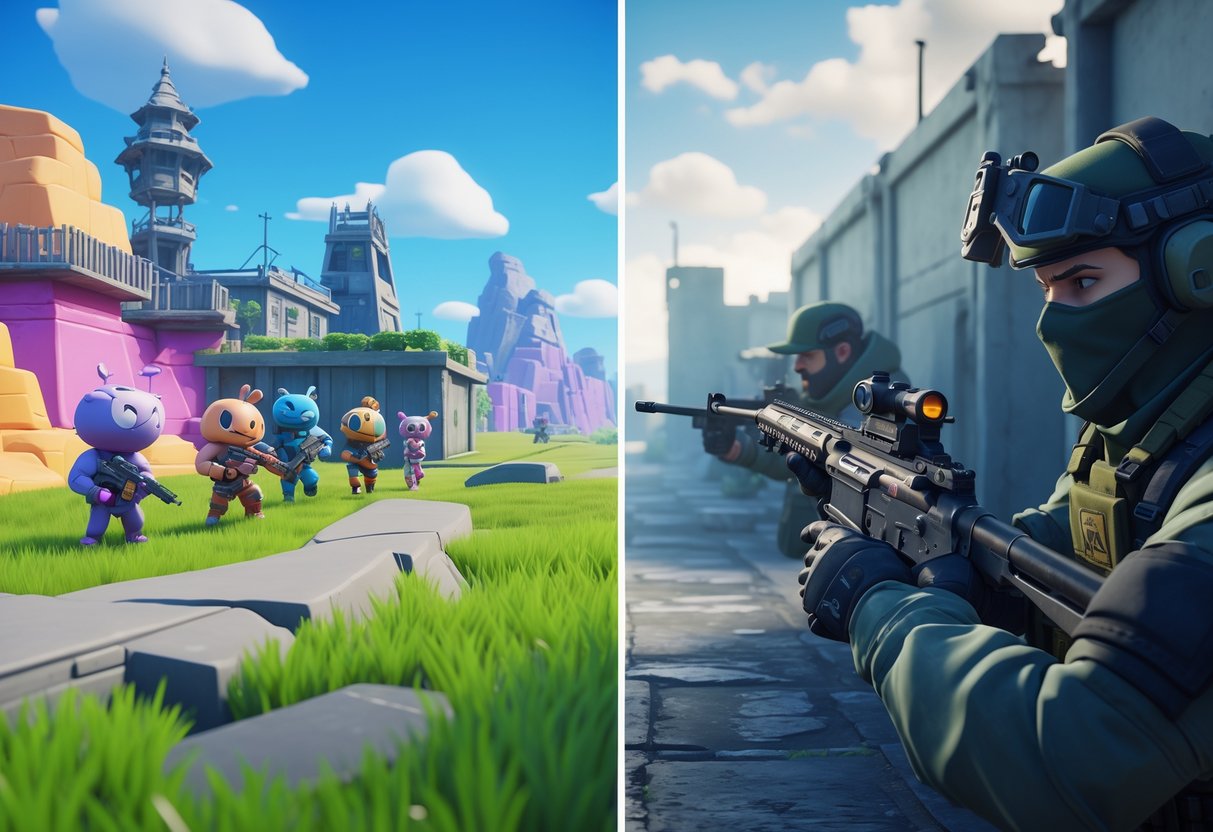
Ballistic isn’t launching into an empty space—it’s up against heavyweights like VALORANT, Rainbow Six Siege, and Call of Duty. Each of these games brings something different, which highlights both Ballistic’s strengths and its shortcomings.
How Ballistic Stacks Up Against VALORANT
VALORANT probably comes closest to Ballistic. Both games go for 5v5 bomb-defusal with a tactical twist.
Agent abilities versus Flex gadgets is the big one. VALORANT’s agents totally change how each round plays out, while Ballistic’s Flex gadgets let you pick your gear but don’t shake up the core gameplay as much.
The weapon economy works differently too. VALORANT makes you manage money across rounds, planning buys and saves. Ballistic keeps it simple, which is easier for new players but can feel less strategic.
Map rotation is another area where VALORANT wins. With more than 10 maps, there’s always something new. Ballistic, right now, only has Skyline 10.
Competitive scene? VALORANT already has seasons, pro leagues, and big tournaments. Ballistic’s competitive side is still getting off the ground.
Influence of Rainbow Six Siege
Rainbow Six Siege goes all-in on tactical realism. Destructible walls and special gadgets add layers of strategy Ballistic just doesn’t have.
Environmental destruction is Siege’s big hook. Players can blow open new sightlines and reshape the map mid-match. Ballistic’s maps stay pretty static, more like classic shooters.
Operator roles in Siege also run deeper. Each operator fills a unique tactical niche. Ballistic’s system feels broader, not as specialized.
Match length is another difference. Siege matches can run over an hour with overtime. Ballistic’s first-to-seven format keeps things fast and casual.
Siege’s learning curve is steep, and that scares off some new players. Ballistic tries to be way more accessible right out of the gate.
Lessons Learned From COD
Call of Duty’s Search and Destroy mode paved the way for tactical shooters in big franchises. COD proved tactical modes could survive in a mainstream game.
Accessibility is baked into Ballistic’s design. COD showed you need to keep things simple to pull in a big audience. Ballistic follows that lead with quick matches and easy-to-understand economies.
Integration is tricky, though. COD’s tactical modes sometimes feel like an afterthought. Ballistic faces the same challenge inside Fortnite.
Content updates are key. COD keeps its tactical modes alive with new maps and guns. Ballistic will need a similar steady flow to keep players coming back.
Balancing casual and competitive play isn’t easy. COD never really nailed it, and Ballistic might struggle too—especially since it dropped casual lobbies so early.
In-Game Economy and Progression
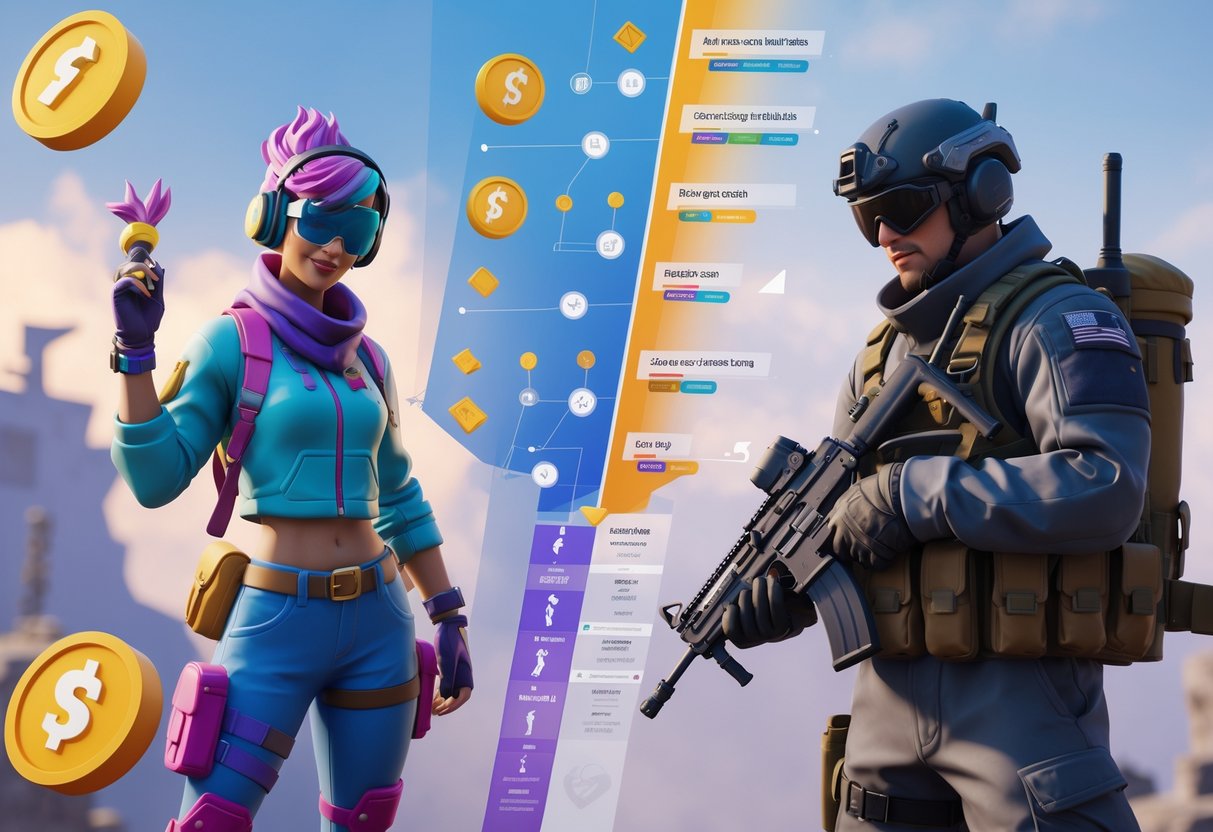
Both games handle money and buying gear in their own ways. CS2 sticks with a more complicated system that rewards smart spending, while Fortnite Ballistic keeps things simple for speed.
Buy Phase Systems
CS2’s economy makes you think a few rounds ahead. You earn cash for winning rounds, getting kills, or even losing.
If you blow all your money early and lose, you’ll end up stuck on “eco rounds” with almost no gear. Teams have to plan when to buy big or save up.
- Income changes based on round results
- Kill rewards differ by weapon
- Losing streaks boost your loss bonus
- Surviving lets you keep your gear
Fortnite Ballistic just hands out a set number of credits each round, no matter how you did before.
That makes decisions faster and easier. You don’t get punished as harshly for bad rounds, but you lose some strategic depth.
Resource Management Differences
CS2 makes you manage money for the whole match. What you spend early will affect what you can buy later.
Teams often coordinate buys, dropping weapons for teammates if someone’s short on cash.
Ballistic’s Flex gadget system changes things. Once you pick a gadget, only you can buy and use it for the rest of the match.
Key differences:
- CS2: Teams can share weapons
- Ballistic: Flex gadgets are locked to each player
- CS2: Complex rewards and punishments in the economy
- Ballistic: Simple, fixed credits every round
CS2 pushes teams to talk and plan together. Ballistic puts more focus on what you do as an individual each round.
Technical Performance and Bugs
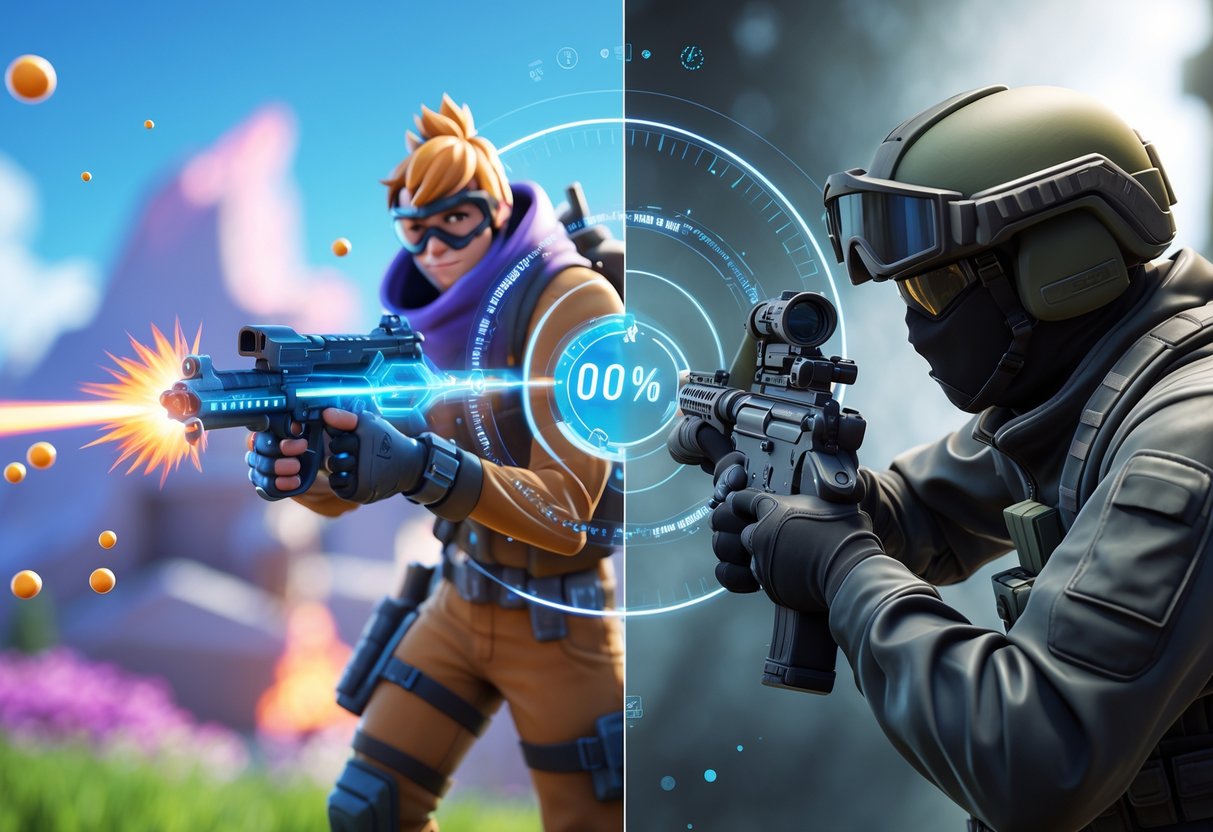
Fortnite Ballistic is still in early access, so you’ll run into more bugs and issues than you’d expect in CS2’s polished world. Sometimes it really gets in the way.
Connection Issues and Early Access Bugs
Since December 2024, Ballistic’s servers have struggled. Players get booted from ranked matches more than you’d hope.
The early access tag shows up in a bunch of ways:
- Matchmaking queues can drag on for 2-3 minutes
- Audio bugs—sometimes footsteps just vanish
- Hit registration is spotty, so shots that should land don’t
- Frame drops hit older PCs during chaos
Epic Games yanks features with barely any warning. They pulled casual play right after launch, so now it’s ranked or nothing.
Crashes also happen more than they should. Plenty of players report losing progress when Ballistic shuts down mid-match.
Impact on Gameplay Experience
These technical issues really ruin the moment and honestly, you just don’t see that in CS2. Connection problems break up the tactical flow that makes competitive shooters so addictive.
CS2’s been around for ages, so Valve already ironed out most of the bugs. The game runs smoothly on almost any system, and crashes or disconnects are pretty rare.
Fortnite Ballistic’s bugs hurt competitive integrity. When shots don’t register, skilled players end up losing matches they probably should’ve won. That kind of stuff just messes with the ranking system.
Since there’s only one map, those problems stand out even more. Players notice the repetition and can’t really ignore technical issues.
A lot of players just go back to CS2 when Ballistic acts up. The difference in reliability is obvious, especially when you’re in the middle of a ranked match.
Developer Intentions and Future Updates
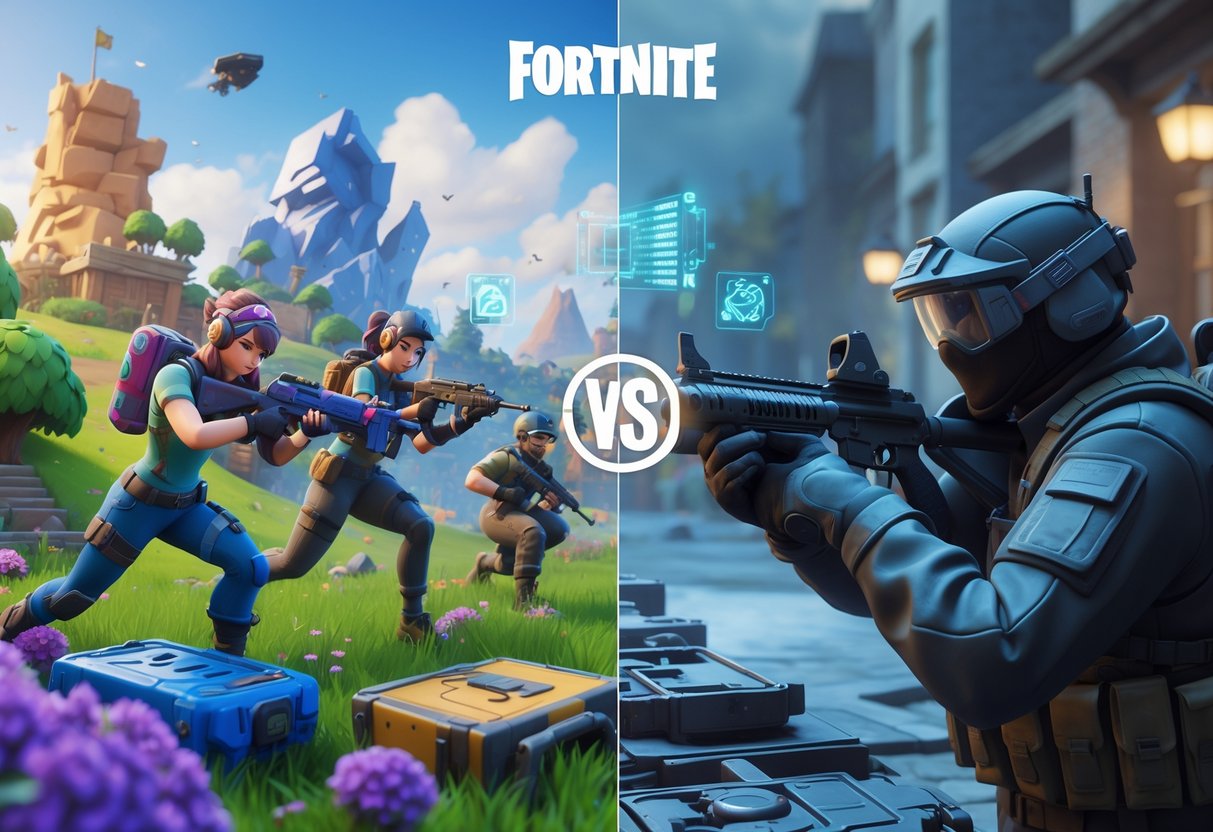
Epic Games looks at Ballistic as part of their bigger plan to turn Fortnite into a universal gaming platform. The mode’s still in early access, but they’ve promised new content and improvements soon.
Epic Games’ Strategy
Epic Games built Ballistic to push Fortnite beyond just battle royale. They’re clearly aiming for a universal game that covers all kinds of genres.
Ballistic marks Fortnite’s first real step into the competitive tactical shooter scene. Epic dropped the mode in early access on December 11, 2024, to see how players would react.
They took out casual play not long after launch. That move shows Epic wants Ballistic to be a serious competitive experience instead of just something for fun.
Ballistic fits into Epic Games’ broader plan:
- Turn Fortnite into a multi-genre platform
- Go head-to-head with other tactical shooters
- Bring in players who like first-person games
- Give current Fortnite fans new stuff to keep them interested
Epic treats Ballistic as just another part of Fortnite, not a separate game. That way, they can try big changes without risking a whole new launch.
Planned Features and Improvements
Epic says they’re working on updates to fix Ballistic’s current problems. Right now, the mode doesn’t offer as much as established games like CS2.
Key improvements in development:
- More maps instead of just Skyline 10
- Bigger weapon selection (currently stuck at 10)
- New tactical gadgets and equipment options
- Better competitive ranking system
The devs want to add more maps so Ballistic will have choices like CS2. Counter-Strike 2 gives you over 15-16 maps across different modes, while Ballistic just has one right now.
Weapon variety is a big deal for Epic. CS2 has over 20 weapons, but Ballistic only offers 10 at the moment.
Epic might make Ballistic a permanent mode after testing wraps up. They’re watching player feedback and engagement stats before making any final call.
The team is also working on the economy system and tactical depth. Feedback says these areas still need a lot of work if Ballistic wants to compete with the big names.
Frequently Asked Questions
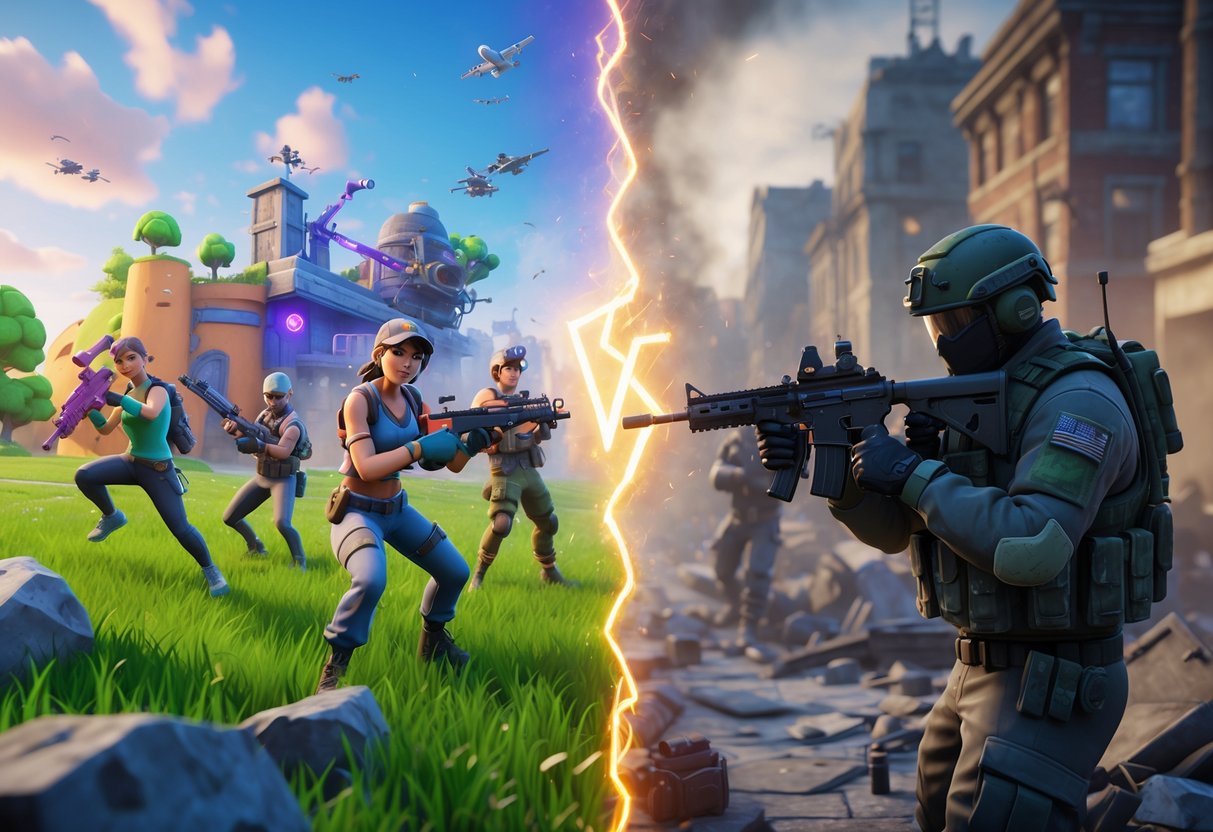
Players always have tons of questions about weapon mechanics, performance, and how things actually play out in these two tactical shooters. Here are the answers to some of the most common concerns about gameplay, weapon stats, and overall player experience.
What are the distinguishing features between Ballistic and CS2 in Fortnite?
Fortnite Ballistic is a 5v5 tactical shooter mode that just launched in December 2024. It uses a first-person view with bomb-planting objectives, kind of like other tactical shooters.
CS2 gives you over 20 weapons, but Ballistic only has 10 options so far. Ballistic matches end quicker, needing just 7 rounds to win compared to CS2’s 13.
Ballistic has unique Flex gadgets that players can buy for themselves. In CS2, teammates can drop and share most weapons and gear freely.
How do the recoil patterns of Ballistic and CS2 compare?
Both games use recoil patterns that actually take practice to master. Ballistic mixes in Fortnite’s movement—so you can sprint, slide, and vault while fighting.
CS2 sticks to the classic Counter-Strike recoil style that pros have learned over the years. Weapon handling feels stiffer and more precise compared to Ballistic’s looser, more mobile system.
If you switch between games, you’ll probably need a bit to get used to the different recoil. Each game rewards different muscle memory and spray control.
Can you break down the damage output differences between the two weapons?
Ballistic’s still in early access, so detailed weapon stats aren’t out there yet. The damage model follows the usual tactical shooter setup—headshots hurt a lot more.
CS2 gives you precise damage stats for every weapon, including different ranges and armor types. Pro players rely on those numbers for tactical choices.
Both games use similar damage drop-off at long range. Body shots need a few hits, but headshots can finish someone fast.
Are there any specific situations where one weapon outperforms the other?
Ballistic’s movement lets you play way more aggressively with sliding and vaulting. That opens up fast entry moves you just can’t do in CS2.
CS2 really shines in tactical positioning and using utility. Its big map pool creates lots of different combat situations to test weapon strengths.
Ballistic feels smoother in close fights because of all the movement options. For long-range, though, CS2’s precise weapon handling and set sight lines usually win out.
Could you elaborate on the ammo capacity and reload times of Ballistic versus CS2?
Ballistic sticks to modern FPS standards for ammo and reload speeds. With just a handful of weapons, you don’t have to worry about too many ammo types.
CS2 mixes things up with different ammo capacities across its huge arsenal. Players have to think about the economy when buying weapons with different ammo needs.
Reload timing matters a lot in both games, especially in clutch moments. Players who manage their ammo well usually come out on top.
What have players said about the overall usability and preference for the Ballistic and CS2?
A lot of CS2 players really like Ballistic’s shorter match times and how easy it is to jump in. The 7-round setup just makes sense for folks who don’t have hours to spare.
Some tactical shooter fans still lean toward CS2, though. They love its established meta, plus the bigger map pool and all the weapon choices—it just feels deeper, strategy-wise.
Ballistic’s player base? It’s not huge, but the folks who stick around seem pretty committed. Still, some people wish the mode had more content so it could actually go toe-to-toe with the big tactical shooters out there.







